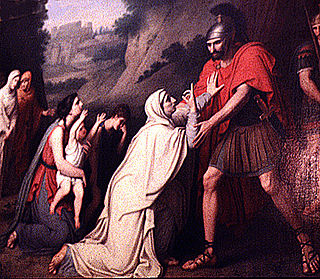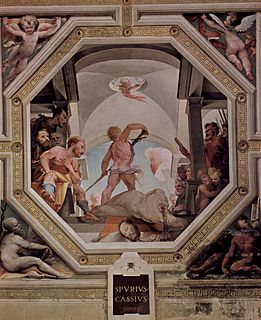
Gaius Marcius Coriolanus was a Roman general who is said to have lived in the 5th century BC. He received his toponymic cognomen "Coriolanus" because of his exceptional valor in a Roman siege of the Volscian city of Corioli. He was subsequently exiled from Rome, and led troops of Rome's enemy the Volsci to besiege the city.
Year 495 BC was a year of the pre-Julian Roman calendar. At the time, it was known as the Year of the Consulship of Sabinus and Priscus. The denomination 495 BC for this year has been used since the early medieval period, when the Anno Domini calendar era became the prevalent method in Europe for naming years.
Ferentina was the patron goddess of the city Ferentinum, Latium. She was protector of the Latin commonwealth. She was also closely associated with the Roman Empire.

The Volsci were an Italic Osco-Umbrian tribe, well known in the history of the first century of the Roman Republic. At the time they inhabited the partly hilly, partly marshy district of the south of Latium, bounded by the Aurunci and Samnites on the south, the Hernici on the east, and stretching roughly from Norba and Cora in the north to Antium in the south. Rivals of Rome for several hundred years, their territories were taken over by and assimilated into the growing republic by 300 BCE. Rome's first emperor Augustus was of Volscian descent.

Spurius Cassius Viscellinus or Vecellinus was one of the most distinguished men of the early Roman Republic. He was three times consul, and celebrated two triumphs. He was the first magister equitum, and the author of the first agrarian law. The year following his last consulship, he was accused of aiming at regal power, and was put to death by the patricians.

The Battle of Lake Regillus was a legendary Roman victory over the Latin League shortly after the establishment of the Roman Republic and as part of a wider Latin War. The Latins were led by an elderly Lucius Tarquinius Superbus, the seventh and last King of Rome, who had been expelled in 509 BC, and his son-in-law, Octavius Mamilius, the dictator of Tusculum. The battle marked the final attempt of the Tarquins to reclaim their throne. According to legend, Castor and Pollux fought on the side of the Romans.
Appius Claudius Sabinus Regillensis or Inregillensis was the legendary founder of the Roman gens Claudia, and consul in 495 BC. He was the leading figure of the aristocratic party in the early Roman Republic.
The Cluilian trench was a huge military trench that surrounded ancient Rome about four to five miles outside the city made by the army of Alba Longa during the war between Alba Longa and Rome in the middle of the seventh century BC. It was named after the Alban king, Gaius Cluilius.
Suessa Pometia was an ancient city of Latium, which had ceased to exist in historical times. Although the modern city of Pomezia is named after it, the exact location of the ancient city is unknown.
The Roman–Etruscan Wars were a series of wars fought between ancient Rome and the Etruscans. Information about many of the wars is limited, particularly those in the early parts of Rome's history, and in large part is known from ancient texts alone. The conquest of Etruria was completed in 265–264 BC.
The Roman–Latin wars were a series of wars fought between ancient Rome and the Latins, from the earliest stages of the history of Rome until the final subjugation of the Latins to Rome in the aftermath of the Latin War.
The Roman–Volscian wars were a series of wars fought between the Roman Republic and the Volsci, an ancient Italic people. Volscian migration into southern Latium led to conflict with that region's old inhabitants, the Latins under leadership of Rome, the region's dominant city-state. By the late 5th century BC, the Volsci were increasingly on the defensive and by the end of the Samnite Wars had been incorporated into the Roman Republic. The ancient historians devoted considerable space to Volscian wars in their accounts of the early Roman Republic, but the historical accuracy of much of this material has been questioned by modern historians.
The Roman conquest of the Hernici, an ancient Italic people, took place during the 4th century BC. For most of the 5th century BC, the Roman Republic had been allied with the other Latin states and the Hernici to successfully fend off the Aequi and the Volsci. In the early 4th century BC, this alliance fell apart. A war fought between Rome and the Hernici in the years 366 - 358 BC ended in Roman victory and the submission of the Hernici. Rome also defeated a rebellion by some Hernician cities in 307 - 306 BC. The rebellious Hernici were incorporated directly into the Roman Republic, while those who had stayed loyal retained their autonomy and nominal independence. In the course of the following century, the Hernici became indistinguishable from their Latin and Roman neighbours and disappeared as a separate people.
Publius Servilius Priscus Structus was a Roman statesman who served as Senator and Consul.

Ecetra was a town of the ancient Volsci tribe of central Italy. Its location is no longer known.
The Roman-Aequian wars were a series of wars during the early expansion of ancient Rome in central Italy against their eastern neighbours, the Aequi.
Longula was a town in ancient times in the territory of the Volsci in central Italy. It was located south of Rome, and just north of the Volscian capital Antium.
Pollusca was a town in ancient times in the territory of the Volsci in central Italy. It was located south of Rome, north of the Volscian capital Antium, and just west of Corioli.
Pedum was an ancient town of Latium in central Italy, located between Tibur and Praeneste, near modern Gallicano nel Lazio. The town was a member of the Latin League.
The Battle of Pometia took place in 502 BC, a year after a revolt by two Latin towns, Pometia and Cora, against Rome. A Roman army led by the consuls Agrippa Menenius Lanatus and Publius Postumius Tubertus was eventually successful in forcing the Pometians to surrender.




